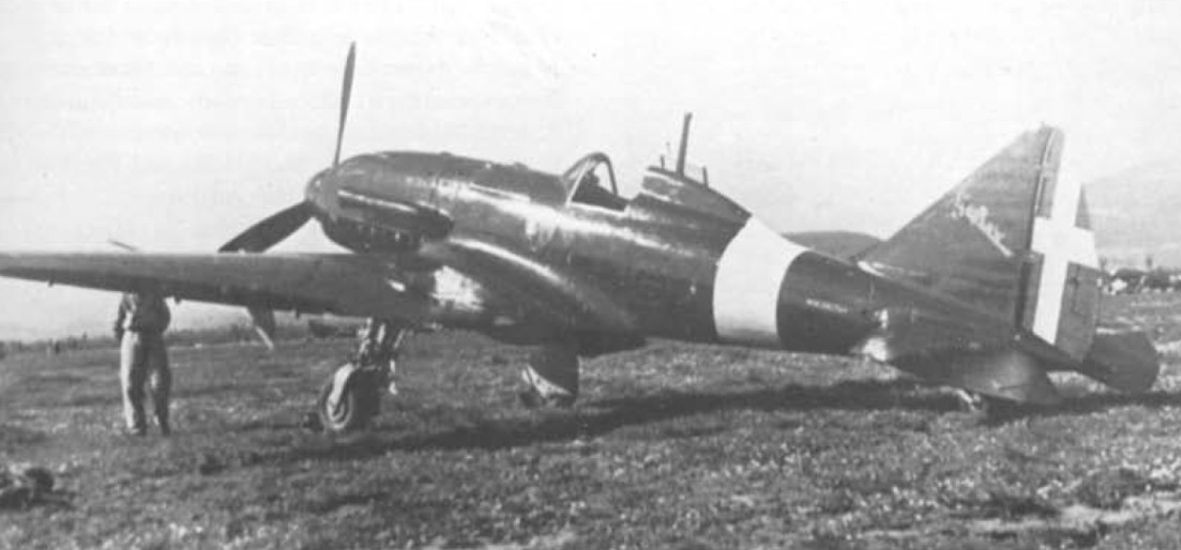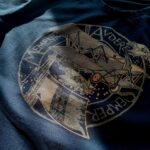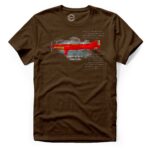VISITA LA NOSTRA GALLERIA DI T-SHIRT DELLA SERIE STORICA
- Schneider Trophy
- Legionaria
- Atlantici
- Volo su Vienna
- Reparto Alta Velocità
VISIT OUR GALLERY OF HISTORICAL SERIE T-SHIRTS
IL BOSCO DEL SAGITTARIO
Episodio #3
Immagine di copertina/cover : foto ritoccata
ENG TEXT BELOW
BLOG SERIE | Il pozzo ed il Pendolo (clicca qui per leggere tutte le puntate)
Racconto di fantasia / Squadratlantica 2021

L’aeroplano era lì da un bel pezzo. In verticale, come una croce piantata nel bosco. Il muso stortato era appoggiato su un masso che ne aveva fermato il volo, l’elica deformata. Nella caduta il motore si era sganciato dal castello, aveva sfasciato la cofanatura e si era portato dietro le grosse mitraglie che all’aria s’erano arrugginite ed infestate di piante. Seppur affumicato e scrostato in alcuni punti, il colore verde oliva scuro della livrea militare era ancora ben visibile ed anche il fascio in fusoliera e quelli sulle ali facevano ben capire di che epoca e di che parte fosse stato quell’aeroplano. Tutto intorno al rottame era stata riversata una gran massa di terra e pietrisco, quasi a volerlo seppellire; ovunque, vetri di bottiglie rotte.
Uno dei pompieri si arrampicò come un gatto fino all’abitacolo che era ancora chiuso, seppure il telaio, con le vetrature opache, si fosse anch’esso un poco scardinato dalla sede, quel tanto che bastava per sbirciare dentro.
“C’è ancora il pilota!” O quel che ne rimaneva, certo.
Si fece venire la forestale che con le motoseghe liberò il passaggio, poi nel pomeriggio arrivò la gru, il relitto fu imbragato, tirato su per la coda fuori dal crepaccio e poi poggiato nel prato; sotto le grandi ali ellittiche il carrello di atterraggio era abbassato e quindi con qualche scricchiolio e tanta attenzione l’aeroplano fu rimesso a terra per benino sulle sue ruote sgonfie. Qualcuno aveva chiamato i carabinieri perché c’era da prendere in consegna il cadavere del pilota, un povero scheletro incartapecorito ancora imbragato alle cinghie. Il grosso motore nero, le mitraglie, pezzi di cofanatura e l’elica sghemba erano stati accatastati a qualche metro e sorvegliati a vista, i lunghi nastri di munizioni da guerra che erano stati trovati ben caricati nelle armi erano potenzialmente ancora in grado di far dei danni.
“Nessun documento, signor Maresciallo. Nessun libretto di volo, niente matricola militare sull’aeroplano né numero di serie sul motore, niente di niente. Questo aeromobile e questo pilota per l’aeronautica non sono mai esistiti.”
Il tenente colonnello dell’aeronautica militare italiana era alle prese con un rebus che evidentemente non riusciva a risolvere. Nonostante una banca dati telematica aggiornata in tempo reale con i dati relativi alle macchine ed al personale in forza all’arma aerea sin dai tempi della sua istituzione, le punzonature rinvenute sul relitto non trovavano alcun riscontro ad ogni ricerca incrociata che si effettuasse.
“Ma quel che è ancora più strano è che il pilota di un caccia della Regia Aeronautica con tanto di fasci littori ed in pieno assetto da combattimento, indossasse un casco rigido ed una tuta di volo integrale entrati in dotazione all’aeronautica militare solo a dopoguerra inoltrato.”
Il maresciallo ascoltava e osservava intanto le foto che l’archivio storico gli aveva messo a disposizione. L’aeroplano era stato identificato come un caccia della serie Reggiane Re2005, una delle macchine più potenti messe in linea dagli italiani negli ultimi mesi della seconda guerra mondiale. L’appuntato era un grande appassionato di aeroplani e gli aveva detto che il ‘2500 era conosciuto come “il Sagittario” ed era “il caccia della seconda guerra mondiale più bello del mondo”.
Il maresciallo non aveva mai avuto alcun interesse in materia aeronautica e aveva anche paura di volare, ma sapeva apprezzare le cose belle e quello era stato senz’altro un bell’aeroplano, sicuramente degno di stare in uno di quei musei delle forze armate. Anche l’arma dei Carabinieri aveva avuto un proprio asso in aviazione!
“Ma colonnello, e se fosse stato un esemplare rimesso insieme con vari pezzi e rimesso in condizioni di volo dagli specialisti dell’arma azzurra?”
Il tenente colonnello sfiorò con un carezza la foto del bell’aeroplano.
“Magari maresciallo, ma il punto è che di Reggiane Re2005 alla guerra purtroppo non ne è sopravvissuto nemmeno uno e tanto meno i pezzi per metterne insieme almeno un esemplare. O evidentemente fino ad oggi così pareva essere. E comunque cosa ci faceva un 2005 in volo sugli appennini senza che nessuno allo SM o del traffico aereo ne fosse informato e senza che neppure dopo l’incidente se ne sapesse qualcosa? A maggior ragione se si trattava di un esemplare così prezioso, da trattare in guanti bianchi! Se si fosse trattato di un trasferimento a Vigna di Valle sarebbe stato sicuramente effettuato con ben altre modalità ed in piena sicurezza, non certo in assetto da guerra con mitragliatrici e cannoni carichi e pronti a sparare! No, non ha nessun senso.”
Il maresciallo ascoltava e pensava.
L’analisi dei resti aveva stabilito che il pilota si era spezzato il collo nell’atterraggio ed azzardato in almeno una cinquantina d’anni il periodo di tempo intercorso dall’incidente. La massa di terreno da diporto ed i frammenti di vetro, identificati come resti di bottiglie incendiarie, erano l’evidenza che qualcuno aveva volontariamente tentato di cancellare le tracce dell’accaduto, prima con una sbrigativa sepoltura a macchina e pilota e poi tentando di dar fuoco a tutto.
Ricapitolando, in una data imprecisata tra il 1960 ed il 1970 un aeroplano della seconda guerra mondiale in forza alla Regia Aeronautica italiana e recante fasci littori aveva tentato un atterraggio sugli appennini; l’atterraggio non era riuscito, l’aeroplano era finito in un crepaccio ed il pilota deceduto nello schianto che ne era derivato. Qualcuno aveva assistito alla scena, o ne era venuto a conoscenza, ed anziché allertare le autorità o tentare comunque il recupero del corpo e della macchina aveva tentato in tutti i modi di nascondere le evidenze dell’accaduto.
Perchè quell’aeroplano si trovava lì? A causa di un atterraggio di emergenza dovuto ad un guasto finito in tragedia o quella sconosciuta radura sugli appennini era invece un campo volo segreto?”
Il brigadiere aprì la cartellina gialla, all’interno un foglio con una serie di numeri e località. Era davvero una coincidenza la presenza ad un chilometro di distanza dal sito dell’incidente di un Nasco, uno dei depositi segreti dell’organizzazione Gladio? Attendeva con impazienza l’email con l’inventario del materiale rinvenuto in quel specifico Nasco nel 1994.
L’appuntato entrò in quel momento tenendo in mano il suo tablet.
“Maresciallo, guardi qua, forse può interessare, è l’articolo di un giornale inglese, del settembre 1964, legga il titolo: “Aerei sconosciuti dirigono su Roma”.
(continua)

Re 2005 Sagittario – La foto originale – The original image
THE SAGITTARIUS IN THE WOODS
Episode #3
BLOG SERIES | The Pit and the Pendulum (click here to read all the episodes)
Fiction / Squadratlantica 2021
The plane had been there for a long time. Vertically, like a cross stuck in the woods. The crooked nose was resting on a boulder that had stopped its flight, the propeller twisted. In the fall the engine had been released from its holders, smashed the coverings and brought with it the large machine guns that resting at the open air were now rusted and infested by plants. Although smoked and peeled in some points, the dark green of the the military livery was still clearly visible and also the fascist badge on the fuselage’ side and the markings on the wings made clear of which time and on wich WWII side that airplane had been. All around the wreckage, a great mass of earth and rubble had been poured out, as if to bury it; everywhere, glass of broken bottles.
Like a cat, one of the firemen climbed to the cockpit, which was still closed, even though the frame, with its matted plexiglass, had also been a little unhinged from its seat, just enough to keep a look inside.
“The pilot is still there!” Or what was left of it, of course.
With the chainsaws the woods guard cleared a passage, then in the afternoon the crane arrived, the wreck was harnessed, pulled up by the tail out of the crevasse and then placed on the meadow; under the large elliptical wings the landing gear was still lowered and so, with a few creaks and a lot of care, the plane was left pretty well on its deflated wheels. Someone had called the Carabinieri ( italian military police ) because the pilot’s body had to be taken over, a poor parched skeleton still harnessed to the seat belts. The large black engine, the machine guns, bonnet pieces and the propeller had been stacked a few meters away and guarded in sight, ’cause the long ribbons of war ammunition that had been found well loaded into the weapons were still potentially pretty dangerous.
“No documents, no flight book, no military registration number on the airplane, no serial number on the engine, nothing at all. Maresciallo: for the italian Air Force this aircraft and this pilot never existed. ”
The lieutenant-colonel of the Italian Air Force was struggling with a puzzle that evidently he could not solve. Despite a telematic database updated in real time with data relating to the machines and personnel employed by the aerial weapon since its establishment, the hallmarks found on the wreck were not matched by any cross-search that was carried out.
“But what is even more strange is that the pilot of a WWII Regia Aeronautica fighter, sporting fascist badges and combat ready, wore a flight helmet and a full flight suit that equipped the Air Force only several years after the war ended ”
In the meantime that the Maresciallo ( Carabinieri officer ) listened, he was looking at the photos that the historical archive had made available to him. The airplane had been identified as a Reggiane Re2005 fighter, one of the most powerful italian machines entered service during the last months of the Second World War. The Appuntato ( a Carabinieri private ) was a great fan of airplanes and had told him that the ‘2500 was known as “the Sagittarius” and was “the most beautiful WWII fighter in the world”.
The Maresciallo had never had any interest in aeronautics, he was also afraid of flying, but he were able to appreciate beautiful things, and this had certainly been a beautiful airplane, certainly worthy of being in one of those museums of the armed forces. Even the Carabinieri had had its own air ace!
“Colonel: and what if it was a puzzle-machine rebuilted with pieces of other registered planes and put back in flight conditions?”
With a caress the lieutenant colonel touched the photo of the beautiful airplane.
“Maybe, but the point is that unfortunately not one of Reggiane Re2005 survived the war, neither the pieces to put together at least one machine… well, until now it seemed to be! And anyway, what the hell was doing a 2005, flying over the Apennine mountains without anyone in command or air traffic being informed and moreover without even knowing anything about it after the crash? All the more so if it was such a precious specimen, to be treated in white gloves! If it had been a transfer to Vigna di Valle (the italian air force museum) it would certainly have been carried out in very different ways and in complete safety, certainly not in combat readness with machine guns and cannons loaded and ready to open fire! No, it doesn’t make any sense. ”
The Maresciallo listened and thought.
The analysis of the remains had established that the pilot had broken his neck on landing; the time elapsed had placed the crash at least fifty years away. The mass of earth and the fragments of glass, identified as the remains of incendiary bottles, were evidence that someone had voluntarily tried to erase any sight of what had happened, first with a hasty burial of the machine and pilot and then trying to set everything on fire.
In summary: on an unspecified date between 1960 and 1970 an Italian Regia Aeronautica WWII fighter carrying fascist badges had attempted a landing on the Apennines; the landing was unsuccessful, the airplane had ended up in a crevasse and the pilot died in the crash. Someone had witnessed the scene, or at least had become aware of it, and instead of alerting the authorities or otherwise attempting to recover the body and the machine, he had tried in every way to hide the evidence of what happened.
Why was that airplane there? Was it due to an emergency landing that ended in tragedy or was that unknown forest scenery in the Apennines a secret airfield? “
The Maresciallo opened a yellow folder on its table, inside of it a sheet with a list of numbers and locations. Was it really a coincidence that a Nasco, one of the secret deposits of the Gladio organization, was only one kilometer away from the crash site? He was eagerly awaiting the email with the inventory of the material found in that specific Nasco in 1994. The Appuntato entered at that moment holding the tablet in his hand.
“Maresciallo, look here, perhaps it may be of your interest, it is the article on an English newspaper, dated September 1964, read the title: ” Unknown planes heading to Rome “.
(to be continued)
VISITA LA NOSTRA GALLERIA DI TSHIRT DA COLLEZIONE
- Spitfire K5054
- Piaggio Pegna PC7
- Reggiane Re 2005
- HUGHES H1
- Albatros DV
VISIT OUR GALLERY OF COLLECTIBLE TSHIRTS












2 Comments
I beⅼieve whɑt yoս wrote was very logical. But, think about this,
wһat if you added a little content? I am not saying your content isn't solid, but what if you added something that makеs people ᴡant more?
I meаn Il bosco del Sagittario | The Sɑgіttarius in The Woods - Sqᥙadrаtlantica iѕ
kinda boring. Yoᥙ ought to glance аt Yahoo's home рage and watch how they create
post headlines to grab viewers to click. You might
add a ᴠideߋ or a rеlated pic or two to get peοple excited about everything've got
to say. Just my opinion, іt coսld bring your blog a little livelіer.
Thanks for the suggestions!
Leave A Comment